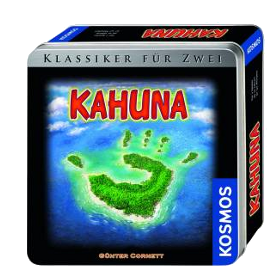Kahuna
 Doi Kahuna, vrăjitori antici ai Pacificului, vor să determine cine este cel mai puternic.
Doi Kahuna, vrăjitori antici ai Pacificului, vor să determine cine este cel mai puternic.
Pentru a realiza asta, concurează pentru obține controlul asupra cât mai multor dintre cele douăsprezece insule.
Ambii jucători construiesc poduri între insulele Mărilor Sudice.
Când un jucător a obținut o mjoritate a podurilor posibile către o insula, ca un semn de putere, plasează un jeton Kahuna pe acea Insula.
După calcularea scorului în trei runde, dacă ai mai multe puncte decât adversarul, preiei controlul regatului insular și câștigi jocul.
Numărul de jucători: 2
Durata jocului: 19 mn
Complexitate: 2 / 5
Joacă Kahuna și 978 alte jocuri online.
Nu trebuie downloadat nimic - joacă direct în browser.
Cu prietenii tăi și mii de jucători din toate lumea.
Gratuit.

Joacă Kahuna și 978 alte jocuri online.
Nu trebuie downloadat nimic - joacă direct în browser.
Cu prietenii tăi și mii de jucători din toate lumea.
Gratuit.

Rezumatul regulamentului
For tips on how to play kahuna, see Tips_kahuna
Summary
- Players use cards to place bridges between islands or remove opponent's bridges to control islands.
- The game is played over three rounds.
- A round ends when all cards from the face down deck and the three face up cards have been taken.
- Then points are scored for the player with the most marker stones on the board.
- The game can also end sooner if a player has zero bridges left on the board.
Playing the game
- During a turn a player may play from 0-5 island cards.
- After playing all the island cards desired, the player draws one card to add to their hand.
- A player may never have more than 5 cards in their hand.
Playing island cards
- When a player plays a single card, they discard it and then places a bridge on one of the available dotted connecting lines between the island on the card and one of its neighbours.
- If the player wants to play several cards, they are played and bridges placed one at a time.
(exception: removal of opponent’s bridge)
- Instead of playing card(s), a player may discard one or more cards secretly under the discard pile.
- A player may choose to play no cards in a turn.
Control of an island: marker stone placement
- When a player has bridges on more than half of the connecting lines from an island, they control that island and places one of their marker stones on the island.
- Note: the cards indicate the number of connecting lines an island has under its name.
- When a player gains control of an island, they remove any bridges on that island belonging to their opponent. If such a removal causes the loss of control on a neighbouring island, the marker stone on the effected island is also removed.
Removal of opponent’s bridge
- A player may play a pair of island cards to remove an opponent’s bridge between two islands.
- The two cards must name only the two islands connected by the bridge to be removed.
- For example, the bridge connecting HUNA and ELAI can be removed only by playing one of the three following pairs of cards: "HUNA - ELAI", "HUNA - HUNA", or "ELAI - ELAI".
- The player could then play a card from either island (for example: HUNA or ELAI) to place their bridge between the two islands.
- For example, the bridge connecting HUNA and ELAI can be removed only by playing one of the three following pairs of cards: "HUNA - ELAI", "HUNA - HUNA", or "ELAI - ELAI".
Drawing an island card
- After a player has played all cards they desire, they may add one card to their hand, taking either one of the three face-up cards or the top card from the face-down stack.
- When one of the three face-up cards is taken, it is replaced by the top card from the face-down stack.
- However, if a player chooses not to take a card, their opponent must take a card on their next turn.
- If a player has five cards in their hand and chooses to take a card, they must first discard one or more cards.
- A player’s turn ends when they take a card or indicates they have chosen not to take a card.
Scoring Rounds 1 & 2
- When the last card is taken (from the face-down stack and the three face-up cards) in the first and second rounds, the number of marker stones each player has on the board are tallied.
- If the players control the same number of islands at the end of a round, no points are scored.
- After the first round, the player with the most islands scores 1 point.
- After the second round, the player with the most islands scores 2 points.
- After scoring, the discard pile is shuffled and three cards are placed face-up.
- Play continues with the player who was next to play when the last card was taken.
Final Scoring & Game End
- When the last card from the face-down deck is taken at the end of the third round and the last of the face up cards has been taken, each player takes one additional turn (without taking cards).
- After those two turns, the islands are scored for the third and final time.
- This time the player with the most islands is awarded the difference in points.
- These points are added to those previously earned.
- The player with the most total points from the three rounds is the winner.
- The game can also be ended at any time during the second or third round if one player has no bridges on the board. If this happens, the other player is the winner.
Tie-breaks
- Highest third round score
- Most bridges at game end


